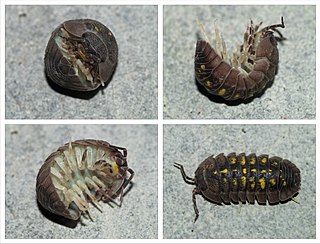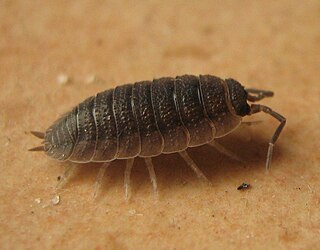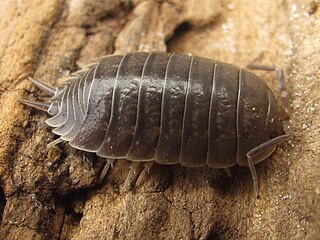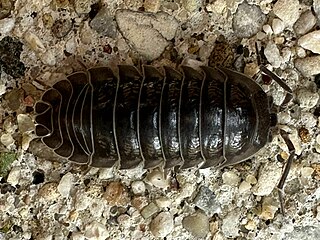
Armadillidium is a genus of the small terrestrial crustacean known as the woodlouse. Armadillidium are also commonly known as pill woodlice, leg pebbles, pill bugs, roly-poly, or potato bugs, and are often confused with pill millipedes such as Glomeris marginata. They are characterised by their ability to roll into a ball ("volvation") when disturbed.

Armadillidiidae is a family of woodlice, a terrestrial crustacean group in the order Isopoda. Unlike members of some other woodlice families, members of this family can roll into a ball, an ability they share with the outwardly similar but unrelated pill millipedes and other animals. This ability gives woodlice in this family their common names of pill bugs or roly polies. Other common names include slaters, potato bugs, butchy boys, and doodle bugs. Most species are native to the Mediterranean Basin, while a few species have wider European distributions. The best-known species, Armadillidium vulgare, was introduced to New England in the early 19th century and has become widespread throughout North America.

Armadillidium vulgare, the common pill-bug, potato bug, common pill woodlouse, roly-poly, slater, doodle bug, or carpenter, is a widespread European species of woodlouse. It is the most extensively investigated terrestrial isopod species. It is native to Mediterranean Europe but has accompanied humans throughout their travels and now are found, naturalized in almost all suitable ecosystems. They are kept as pets by hobbyists for their wide range of possible color variations.

Porcellio scaber, is a species of woodlouse native to Europe but with a cosmopolitan distribution. They are often found in large numbers in most regions, with many species preying on them.

Glomeris marginata is a common European species of pill millipede. It is a short millipede, rounded in cross-section, which is capable of rolling itself up into a ball ("volvation") when disturbed. This behaviour is also found in the pill woodlouse Armadillidium, with which G. marginata is often confused.

Porcellio is a genus of woodlice in the family Porcellionidae. These crustaceans are found essentially worldwide. A well-known species is the common rough woodlouse, Porcellio scaber.

Porcellio laevis is a species of woodlouse in the genus Porcellio. As the species epithet laevis as well as the vernacular name "swift woodlouse" suggests, the species is capable of quick bursts of speed when provoked.

A woodlouse is any crustacean belonging to the suborder Oniscidea within the order Isopoda. They get their name from often being found in old wood, and from louse, a parasitic insect, although woodlice are neither parasitic nor insects.

Gustav Henrik Andreas Budde-Lund was a Danish invertebrate zoologist. In 1868, he co-founded the Entomologisk Forening, alongside Rasmus William Traugott Schlick, Carl August Møller, Andreas Haas and Ivar Frederik Christian Ammitzbøll. He was a student of entomologist J. C. Schiødte, and became a leading authority on terrestrial isopods, describing over 70 genera and around 500 species. He married in 1875 and in 1885 produced his seminal work Crustacea Isopoda terrestria. The woodlouse genus Buddelundiella was named in Budde-Lund's honour by Filippo Silvestri in 1897.

Armadillidium pictum is a species of woodlouse which occurs over most of Europe, except the Mediterranean Basin and Southeast Europe. In the British Isles, it is only known from a few sites, making it by some accounts, "Britain's rarest woodlouse". Since these sites are all remote from human habitation, in Cumbria and Powys, the species is thought to be native rather than introduced.

Hemilepistus reaumuri is a species of woodlouse that lives in and around the deserts of North Africa and the Middle East, "the driest habitat conquered by any species of crustacean". It reaches a length of 22 mm (0.87 in) and a width of up to 12 mm (0.47 in), and has seven pairs of legs which hold its body unusually high off the ground. The species was described in the Description de l'Égypte after the French Campaign in Egypt and Syria of 1798–1801, but was first formally named by Henri Milne-Edwards in 1840 as Porcellio reaumuri. It reached its current scientific name in 1930 after the former subgenus Hemilepistus was raised to the rank of genus.

Armadillidium depressum, the southern pill woodlouse is a large, relatively common British species of woodlouse characterized by its "splayed" appearance.

Helleria brevicornis, the sole species of the monotypic genus Helleria, is a terrestrial woodlouse endemic to the islands and coastal regions of the northern Tyrrhenian sea. H. brevicornis is of interest due to its endemism, unique ecology and basal position in the suborder Oniscidea.

Armadillidium atticum is a European species of woodlouse endemic to Greece. It is a relatively small species and belongs to the so called "Armadillidium insulanum complex".

Armadillidium quinquepustulatum is a European species of woodlouse endemic to France. It is a relatively small to medium-sized species that belongs to the so-called "Armadillidium maculatum group".

Armadillidium phalacronum is a European species of woodlouse endemic to Greece. It is a relatively small-sized species that probably belongs to the so-called "Armadillidium insulanum complex".

Armadillidium maculatum, also known as the zebra isopod or zebra pillbug is an Armadillidium species of woodlouse, named for its black and white patterns. It is native to southern France.

Armadillidium album, also known as the beach pill woodlouse, is a species of isopod within the family Armadillidiidae. The species is salt tolerant, inhabiting coastal sand dunes and saltmarshes within Europe. They can sometimes be found under driftwood or burrowed within grains of sand of which their colour pattern mimics.





















